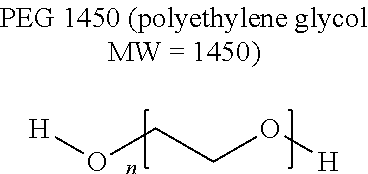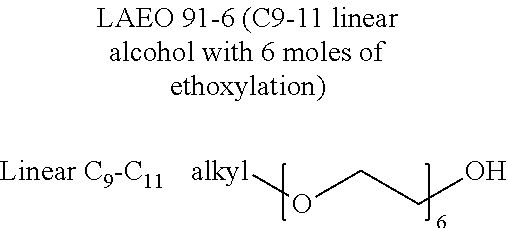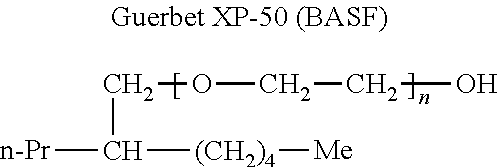Surfactant blends for cleaning filtration membranes
a technology of filtration membrane and surfactant, which is applied in the direction of cleaning using liquids, detergent compounding agents, transportation and packaging, etc., can solve the problems of not being able to predict the choice of surfactants that will be useful in membrane cleaning and the inability to use them
- Summary
- Abstract
- Description
- Claims
- Application Information
AI Technical Summary
Benefits of technology
Problems solved by technology
Method used
Image
Examples
examples
Purpose / Background
[0145]The intent of this invention was to find a suitable replacement for the surfactant nonylphenol ethoxylate (NPE 9.5) and tridecyl alcohol ethoxylate (TDA-9), also known as Ultrasil 01 (U01) and Ultrasil 06 (U06), respectively. The surfactants and polymers are used as a membrane cleaning adjuvant for improved removal of high fat, protein, and other soils and in some cases improving the wetting-out or permeation properties. Other considerations for a successful replacement chemistry are good rinsing characteristics, low foaming, good stainless steel cleaning properties, and relatively low cost.
[0146]This change is required due to environmental concerns from the Environmental Protection Agency (EPA) over the use of alkyl phenol ethoxylates (APEs). TDA-9 (U06) was an attempt at replacing NPE 9.5 (U01) in the Ultrasil product line for cleaning process membrane systems, but growing customer concerns and supporting data suggested some negative effects on membrane per...
example 2
[0176]Attempts to generalize various surfactants with ability to perform in the membrane cleaning functions of the invention have shown that there seem to be no clear generalizations and a particular surfactants ability to function is unpredictable.
[0177]For example, attempts were made to generalize surfactants based upon ability to rinse from the membrane. FIG. 9 shows that for PES membranes polysorbate 20 and LAEO 12-15 (7EO) had poor rinse characteristics (highest number of stripping / rinsing cycles and performed poorly on the membrane cleaning test, (FIG. 2). FIG. 10 shows that this trend also exists for PVDF membranes, see also FIG. 1. However, hexyl glucoside performed well on the membrane during production, but rinsed poorly. This is a likely candidate as a unique co-surfactant to this booster system.
[0178]There are a number of theories of functionality based on molecular structure of the surfactant / polymer and membrane. The higher the molecular weight and extensive branching ...
example 3
Glue Line Testing and Contact Angle
[0180]Polymeric membranes have glue lines that can be susceptible to penetration by aggressive surfactant and / or solvent solutions. Applicants tested the compositions of the invention in this scenario. The results are show in FIGS. 11 and 12 (higher is better). From the figures, one can see that KX-7030 is better on this PES membrane (FIG. 11) in FIG. 12 for the PVDF membrane, one cart see that KX-7030 is about the same. This suggests that KX-7030 is acceptable and in some cases is better than Ultrasil 01 (NPE) or Ultrasil 06 (TDA)
[0181]Next contact angle was investigated.
[0182]Contact angles were also used to predict performance. During the PES testing, it appeared high contact angles greater than 25, such as the case was with poor performing U06 (TDA), and lower contact angles of less than 25 such as good performing PEG and NPE adequately predict performance on the membrane. For the higher molecular weigh cutoff PVDF membranes, contact angles did...
PUM
| Property | Measurement | Unit |
|---|---|---|
| contact angle | aaaaa | aaaaa |
| contact angle | aaaaa | aaaaa |
| weight percent | aaaaa | aaaaa |
Abstract
Description
Claims
Application Information
 Login to View More
Login to View More - R&D
- Intellectual Property
- Life Sciences
- Materials
- Tech Scout
- Unparalleled Data Quality
- Higher Quality Content
- 60% Fewer Hallucinations
Browse by: Latest US Patents, China's latest patents, Technical Efficacy Thesaurus, Application Domain, Technology Topic, Popular Technical Reports.
© 2025 PatSnap. All rights reserved.Legal|Privacy policy|Modern Slavery Act Transparency Statement|Sitemap|About US| Contact US: help@patsnap.com



